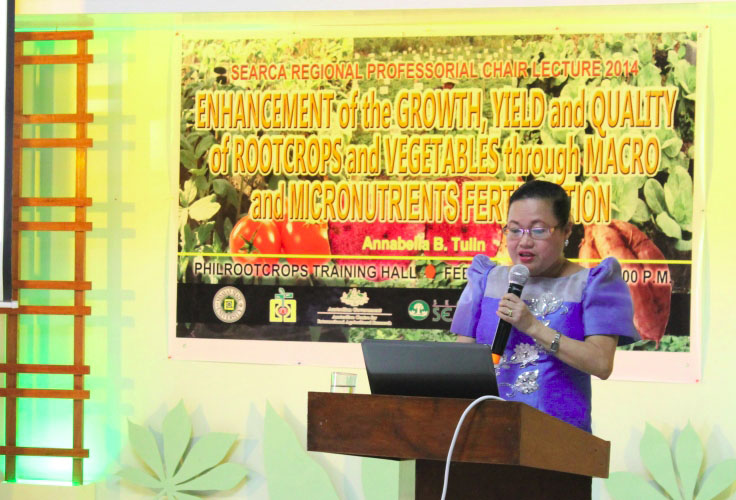Soil micronutrients can work miracles, says VSU soil scientist
- Details
-
Published: 08 April 2014
 Dr. Anabella B. Tulin, a Soil Scientist, disclosed during her SEARCA Regional Professorial Chair Lecture on February 26, 2014 at the Training Hall of PhilRootcrops how she became interested in soil science especially on its fertility. Her first study on soils revealed a very simple secret to improve the growth, yield, and quality of root crops and vegetables.
Dr. Anabella B. Tulin, a Soil Scientist, disclosed during her SEARCA Regional Professorial Chair Lecture on February 26, 2014 at the Training Hall of PhilRootcrops how she became interested in soil science especially on its fertility. Her first study on soils revealed a very simple secret to improve the growth, yield, and quality of root crops and vegetables.
“It’s like a miracle—that you just add a little micronutrients to the soil in addition to macronutrient fertilizers, then the yield and even the content of phytochemicals such as anthocyanin will be improved,” said Tulin.
Nitrogen, phosphorus, and potassium (NPK) are the primary nutrients that the soil needs. Tulin said nitrogen is most important in the formation of chlorophyll, the green pigment in leaves essential in plant food manufacture, and growth of plants. Plants need phosphorus and potassium to improve their quality and fruit production, respectively. In root crops, potassium is important in tuber formation.
Aside from these primary macronutrients, Tulin explained that plants need calcium, magnesium and sulfur which are known as secondary macronutrients, and micronutrients such as manganese, zinc, copper, iron, cobalt, molybdenum, and nickel. “These micronutrients have different specific physiological functions to the plants. Calcium, for instance, is important in nut development in peanuts,” she said.
Tulin said, micronutrients can enhance NPK absorption. By adding micronutrients, the plant can readily take up the macronutrients it needs.
In her study, Tulin found out that applying 45-45-45 kg N-P205-K2O with 8 kg/ha Biozom-200 can give optimum growth and yield to root crops such as sweetpotato and yam. Biozome-200 is a micronutrient soil conditioner which is normally added to macronutrient fertilizers.
Tulin advised that it is important to diagnose the soil to find out what nutrients are lacking. This can be done by examining the plants’ growth and check for the appearance of nutrient deficiency symptoms on the leaves of the plants. Purple patches on the leaves in pechay and sweetpotato, for instance, can mean the soil lacks phosphorus.
Another diagnostic tool is the soil test kit which can be purchased at the Bureau of Soils and Water Management or at the University of the Philippines Los Baños.
Tulin encouraged soil science students to explore the potential of molybdenum, nickel, and copper to enhance the anthocyanin content of certain root crops.
Finally, Tulin explained the economic benefit in relation to macro and micro-nutrition of the soil. A yield increase of up to 300% in root crops can provide an income of more than a hundred thousand pesos. After the lecture, Tulin left the audience with a fact: “there is money in the soil” through a video presentation entitled “Dirt Rich” referring to the soil.
Tulin is a Professor VI at PhilRootcrops and a soil science faculty at the Department of Agronomy and Soil Science.

